BABOON FACTS
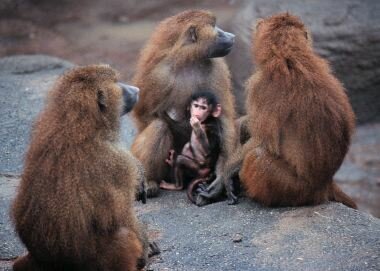
| Family: Cercopithecidae |
Subfamily: Cercopithecinae |
| Genus: Papio |
Species: hamadryas |
- anubis (olive)
- cynocephalus (yellow)
- hamadryas (hamadryas)
- papio (guinea)
- ursinus (chacma)
-
Subspecies: five
-
Taxonomy is disputed. Until recently all were thought to be separate species. Geladas, though a separate species, are usually grouped in with the common name, baboons.
 Appearance:
Appearance:
All are among the largest of monkeys. All have cheek pouches, enabling them to "eat and run," large canine teeth and long snouts that give them a doglike appearance. They all possess large ischial callosities. In guinea baboons these are bright red. Baboon ears and faces are naked. Forelimbs and hindlimbs are about equal in length. Tails vary, but are generally long.
Their fur is dense and their coloring varies somewhat, though most coats contain grey or brown. Olive baboons have a greenish olive coat; yellow baboons are yellowish brown; guinea baboons are reddish brown; chacmas range from yellowish gray to almost black.
Body lengths range between 50-60cm. Weight ranges are from about 60-30lbs, or heavier, with the savanna baboons (olive and yellow) being the largest.
They are sexually dimorphic in size and appearance, with males being larger, often twice as large, and having a more distinctive appearance. Males often have manes and/or "capes" of hair around their shoulders. This is especially pronounced in the hamadryas subspecies. This added coat enhances the males' appearance, making them seem even larger. Females display prominent estrus swelling.
Range and Diet:
Baboons have adapted to various habitats ranging from rain forests to deserts to seashores, and are found on mountains, cliffs, trees and savannas. They are found throughout a good part of Africa, depending on the species. Olive and yellow baboons are found in equatorial Africa, while hamadryas are in a much smaller area in the northeast ranging into Saudi Arabia. Guineas are on the west coast while chacmas are found only in southern Africa. Because of their large size, and often impoverished environment, baboons often must travel great distances each day to get enough to eat. They are fairly omnivorous, eating many species and all parts of plants - fruit, seeds, nuts, roots, leaves, flowers, tubers - and a variety of animal prey. Some will raid crops, or beg humans for food.
Behavior and Social Structure:
 All are mainly terrestrial and diurnal. They walk quadrupedally, but can stand bipedally to survey the landscape. Troop size can vary, but can get quite large. All live in a multimale-multifemale social structure, where males fiercely defend the group. Hamadryas and guinea baboons have fission-fusion communities in which the basic units are a male and several females. Baboons will normally sleep in large troops, no matter what their foraging patterns, in some high place where they are protected from predators.
All are mainly terrestrial and diurnal. They walk quadrupedally, but can stand bipedally to survey the landscape. Troop size can vary, but can get quite large. All live in a multimale-multifemale social structure, where males fiercely defend the group. Hamadryas and guinea baboons have fission-fusion communities in which the basic units are a male and several females. Baboons will normally sleep in large troops, no matter what their foraging patterns, in some high place where they are protected from predators.
All baboons have strong dominance hierarchies where ranks are inherited from the females. Females outnumber male group members, though males tend to be dominant, herding females around and determining their foraging direction. Males will often, though not always, emigrate. In hamadryas baboons it is the females that leave their natal troop. Males may change troops more than once in the course of their lives.
Baboons, particularly savanna baboons, have been well-studied, and complex social systems have been reported. Individuals will form strong friendships, and much cooperative behavior has been observed. Female mating choice is not always based on male rank, though studies have shown the alpha male to be normally more successful. Mutual grooming functions as a strong social bond. Social behavior does vary quite a bit between and even within subspecies, and so do group size and composition. Much of this may be related to environment.
Some baboon subspecies have been known to associate and hybridize with other subspecies. Such hybridization seems to have some effect on social behavior as well as appearance.
Baboons communicate through a variety of facial, gestural, postural, olfactory and vocal means. Lip smacking is associated with affiliative behavior. Vocal communications are thought to communication specific information about the environment.
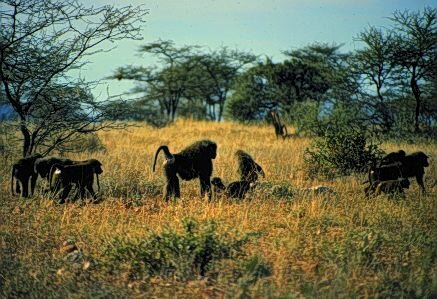
Females reach sexual maturity earlier than males (roughly 50 vs. 60mos, with a greater difference in chacmas.) Estrus cycles run roughly 30-35 days. Gestation time can run from 170-190 days with most falling around 180 days. Infants are born throughout the year though are especially numerous in October through December in South and East Africa. Available resources seem to play a role in both conception and outcome. More conceptions occur when there is a better food supply. One study of olive baboons showed that more males were born if there was less rain in January.
Infants inherit their mothers' ranks and rank also seems to play a role in conception and outcome. Higher ranking yellow baboon females conceive earlier and have more female infants and a lower infant mortality rate. High ranking mothers are more permissive than low ranking, who tend to keep their infants close.
Allomothering may be a common occurrence - in a parentage study of hamadryas, D.G. Smith et al found that over 50% of assigned mothers actually were raising non-offspring. Cannibalistic infanticide has been observed in chacmas. Baboons live around 35-45 years.
Conservation Status:
All baboons but the hamadryas are listed as Lower Risk by CITES II.
Hamadryas are listed as Rare (IUCN.) These are regarded as crop raiders in Ethiopia, and they are trapped for commercial reasons. War has also affected their habitat.
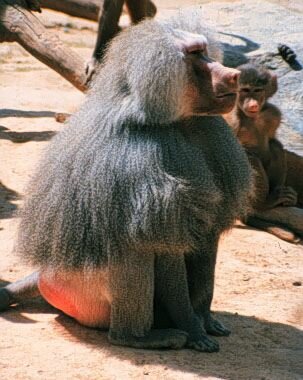 Interesting Baboon Facts:
Interesting Baboon Facts:
Ancient Egyptians considered hamadryas baboons to be the sacred, attendants of Thoth, the scribe of the gods.
Male olive baboons use infants as "social buffers" in dominance struggles.
Baboons are another favorite of research labs - their resistance to HIV has led to many experiments. In 1992 the liver of a yellow baboon was transplanted into a human male with HIV, who later died of infection from the surgery.
Male hamadryas baboons grow their first shoulder cape at age 10.
Male olive baboons greet each other with an elaborate ritual.
Studies suggest that baboons are adept at deception, utilizing the visual perspective of other individuals and using others as social tools.
A hamadryas male can start his own troop by adopting and caring for subadult females.
Baboons are the only primate besides chimpanzees that have been reported to engage in cooperative hunting.
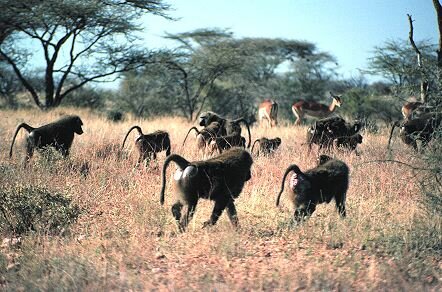
Savanna baboons have often been studied as a model for our early hominid ancestors, who are believed, by many, to have had a similar habitat.
Hamadrayas baboons have the largest day range of any primate. They will walk up to 10km a day (farther distances have been recorded) in search of food.
One cognitive study showed that baboons had the ability to mentally rotate objects.
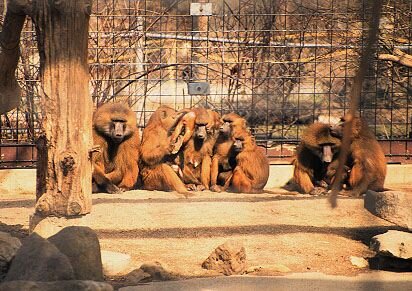
Current Research with Baboons:
(Note: The following are examples of recent research done with these primates, it is by no means an exhaustive list. This list will be periodically updated as more information becomes available. Also, though Mindy's Memory Primate Sanctuary DOES NOT support invasive medical research on primates, some articles of this type will be listed - both for information and as examples of the work that is currently being done with these animals.)
Altmann SA
FORAGING FOR SURVIVAL: YEARLING BABOONS IN AFRICA. Chicago, Univ of Chicago Press, 1998, xii, 609 pp..
Bentley-Condit V
Captive olive baboon infant development and mother-infant proximity. AMERICAN JOURNAL OF PRIMATOLOGY 49(1): 34, 1999. (Abstract)
Bentley-Condit V; Smith EO
Captive olive baboon and feral yellow baboon mother-infant proximity during infants' first three months. AMERICAN JOURNAL OF PRIMATOLOGY 45(2): 169, 1998. (Abstract)
Beyene Gebru S
The role of female mating behavior in hybridization between anubis and hamadryas baboons in Awash, Ethiopia. DISSERTATION ABSTRACTS INTERNATIONAL A59(5): 1648, 1998. (To order: #AAD98-34773. University Microfilms, Inc, Ann Arbor, MI 48106)
Buchanan LS; Leigh SR
Patterns of craniometric sexual dimorphism in papionin primates. AMERICAN JOURNAL OF PHYSICAL ANTHROPOLOGY (Suppl 28): 100, 1999. (Abstract)
Carey, K D; Rice, K
The aged female baboon as a model of menopause. IPS/ASP CONGRESS ABSTRACTS (1996): #079, 1996. (Abstract)
Castles DL; Whiten A
Post-conflict behaviour of wild olive baboons. II. Stress and self- directed behaviour. ETHOLOGY 104(2): 148-160, 1998.
Castles DL; Whiten A
Post-conflict behaviour of wild olive baboons. I. Reconciliation, redirection and consolation. ETHOLOGY 104(2): 126-147, 1998.
Chen LD; Kushwaha RS; McGill HC Jr; Rice KS; Carey KD
Effect of naturally reduced ovarian function on plasma lipoprotein and 27-hydroxycholesterol levels in baboons (Papio sp.). ATHEROSCLEROSIS 136(1): 89-98, 1998.
Chen, L D; Kushwaha, R S; McGill, H C, Jr; Carey, K D
Effect of natural menopause on lipoprotein levels and hepatic sterol 27-hydroxylase activity in baboons (Papio sp). FASEB JOURNAL 11(3): A167, 1997. (Abstract)
Cheney, D L; Seyfarth, R M
Reconciliatory grunts by dominant female baboons influence victim's behaviour. ANIMAL BEHAVIOUR 54(2): 409-418, 1997.
Cowlishaw G
Ecological and social determinants of spacing behaviour in desert baboon groups. BEHAVIORAL ECOLOGY AND SOCIOBIOLOGY 45(1): 67-77, 1999.
Dowhan, R A
Male tactics and female mate choice in corral-living savanna baboons. AMERICAN JOURNAL OF PRIMATOLOGY 42(2) 106, 1997. (Abstract)
Erhart, E M; Coelho, A M, Jr; Bramblett, C A
Kin recognition by paternal half-siblings in captive Papio cynocephalus. AMERICAN JOURNAL OF PRIMATOLOGY 43(2): 147-157, 1997.
Gordon AD
Allometric scaling of articular surface areas in Papio anubis. AMERICAN JOURNAL OF PHYSICAL ANTHROPOLOGY (Suppl 28): 138, 1999. (Abstract)
Guhad, F A; Farah, I O; Chai, D C; Logan-Henfrey, L L
Surgical management of a nasal adenocarcinoma in an olive baboon (Papio cynocephalus). CONTEMPORARY TOPICS IN LABORATORY ANIMAL SCIENCE 36(3): 76-77, 1997.
Henzi SP; Lycett JE; Weingrill T
Mate guarding and risk assessment by male mountain baboons during inter-troop encounters. ANIMAL BEHAVIOUR 55(Pt 6): 1421-1428, 1998.
Jolly, C J; Woolley-Barker, T; Beyene, S; Disotell, T R; Phillips-Conroy, J E
Intergeneric hybrid baboons. INTERNATIONAL JOURNAL OF PRIMATOLOGY 18(4): 597-627, 1997.
Kamal, K B; Boug, A; Brain, P F
Effects of food provisioning on the behaviour of commensal Hamadryas baboons, Papio hamadryas, at Al Hada Mountain in western Saudi Arabia. ZOOLOGY IN THE MIDDLE EAST 14: 11-22, 1997.
Kaplan JR; Phillips-Conroy J; Fontenot MB; Jolly CJ; Fairbanks LA; Mann JJ
Cerebrospinal fluid monoaminergic metabolites differ in wild anubis and hybrid (Anubis hamadryas) baboons: Possible relationships to life history and behavior. NEUROPSYCHOPHARMACOLOGY 20(6): 517-524, 1999.
Kaplan JR; Phillips-Conroy JE; Jolly CJ; Fontenot MB; et al
Cerebrospinal fluid monoaminergic metabolites differ in wild anubis, hamadryas, and hybrid baboons, possibly reflecting variation in life history. AMERICAN JOURNAL OF PHYSICAL ANTHROPOLOGY (Suppl 28): 164, 1999. (Abstract)
Lapin BA; Yakovleva LA; Chikobava MG
Epidemiology of malignant lymphomas and the difference in the molecular-biological structure of retroviruses in high risk group of baboons and in the controls. JOURNAL OF MEDICAL PRIMATOLOGY 28(4/5): 297, 1999. (Abstract)
Lycett JE; Henzi SP; Barrett L
Maternal investment in mountain baboons and the hypothesis of reduced care. BEHAVIORAL ECOLOGY AND SOCIOBIOLOGY 42(1): 49-56, 1998.
Lycett JE; Weingrill T; Henzi SP
Birth patterns in the Drakensberg Mountain baboons (Papio cynocephalus ursinus). SOUTH AFRICAN JOURNAL OF SCIENCE 95(8): 354-356, 1999.
Maestripieri D
The evolution of male-infant interactions in the tribe Papionini (Primates: Cercopithecidae). FOLIA PRIMATOLOGICA 65(5): 247-251, 1998.
Martino MA; Hubbard GB; Butler TM; Hilliard JK
Clinical disease associated with simiam agent 8 infection in the baboon. LABORATORY ANIMAL SCIENCE 48(1): 18-22, 1998.
Moore CM; McKeand J; Witte SM; Hubbard GB; Rogers J; Leland MM
Teratoma with trisomy 16 in baboon (Papio hamadryas). AMERICAN JOURNAL OF PRIMATOLOGY 46(4): 323-332, 1998.
O'Higgins P; Collard M
Facial growth and sexual dimorphism in some papionin species. AMERICAN JOURNAL OF PHYSICAL ANTHROPOLOGY (Suppl 28): 214, 1999. (Abstract)
Palombit, R A; Seyfarth, R M; Cheney, D L
The adaptive value of 'friendships' to female baboons: Experimental and observational evidence. ANIMAL BEHAVIOUR 54(3): 599-614, 1997.
Paterson JD
Aspects of Khaya anthotheca bark consumption in Ugandan forest baboons. Pp. 115 in 4TH INTERNATIONAL ANTHROPOLOGICAL CONGRESS OF ALES HRDLICKA: ABSTRACTS. WORLD ANTHROPOLOGY AT THE TURN OF THE CENTURIES. Sabik D, ed. Prague, SET OUT, 1999. (Abstract)
Petit, O; Abegg, C; Thierry, B
A comparative study of aggression and conciliation in three cercopithecine monkeys (Macaca Fuscata, Macaca nigra, Papio papio). BEHAVIOUR 134(5-6): 415-432, 1997.
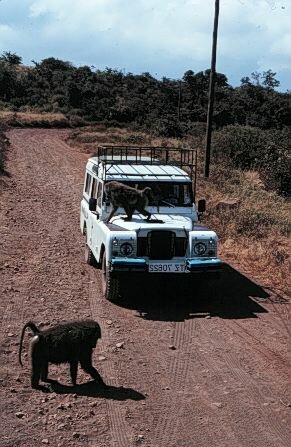
Reed PE; Phillips-Conroy JE; Jolly CJ and Wasser SK.
Differences in cortisol levels of anubis and hamadryas baboons captured in the Awash National Park, Ethiopia. AMERICAN JOURNAL OF PHYSICAL ANTHROPOLOGY (Suppl 26): 186, 1998.
Rogers, J; Hixson, J E
Baboons as an animal model for genetic studies of common human disease. AMERICAN JOURNAL OF HUMAN GENETICS 61(3): 489-493, 1997.
Rubio CA; Hubbard GB
Adenocarcinoma of the cecum with Crohn's-like features in baboons. ANTICANCER RESEARCH 18(2A): 1143-1147, 1998.
Rubio CA; Hubbard GB
A new phenotype of gastric pyloric cells. A study in baboons. IN VIVO 12(5): 543-546, 1998.
Schneider RD
Female social preferences and mating behavior in captive group-living baboons (Papio cynocephalus anubis): An experimental study. DISSERTATION ABSTRACTS INTERNATIONAL B59(7): 3763, 1999. (To order: #AAD98-40644. University Microfilms, Inc, Ann Arbor, MI 48106)
Schultz C; Koppers D; Braak E; Braak H
Tau-positive cytoskeletal pathology in specific neurons and glial cells of the aged baboon. EUROPEAN JOURNAL OF NEUROSCIENCE 10(Suppl): 92, 1998. (Abstract)
Smith, DG; S Kanthaswamy; M Disbrow and JL Wagner.
Reconstruction of parentage in a band of captive hamadryas baboons. INTERNATIONAL JOURNAL OF PRIMATOLOGY 20(3): 415-429, 1999.
Smith DG; Kanthaswamy S; Wagner JL
Paternity and female choice in two groups of Hamadryas baboons. AMERICAN JOURNAL OF PRIMATOLOGY 45(2): 209, 1998. (Abstract)
St George, D
Population genetics of African yellow baboons (Papio hamadryas cynocephalus). DISSERTATION ABSTRACTS INTERNATIONAL A58(4): 1355, 1997. (To order: #AAD97-30207. University Microfilms, Inc, Ann Arbor, MI 48106)
Struckhoff G; Schultz C; Koppers D; Braak E; et al.
Abnormally phosphorylated tau in astrocytes and oligodendrocytes of the aged baboon. EUROPEAN JOURNAL OF NEUROSCIENCE 10(Suppl): 92, 1998. (Abstract)
Wasser SK; Norton GW; Rhine RJ; Klein N; Kleindorfer S
Ageing and social rank effects on the reproductive system of free- ranging yellow baboons (Papio cynocephalus) at Mikumi National Park, Tanzania. HUMAN REPRODUCTION UPDATE 4(4): 430-438, 1998.
Wurz GT; Maenpaa JU; Hubbard GB; Cadman TB; Seymour RC; Soe L; DeGregorio MW
Intratumoral toremifene therapy and tissue distribution in the baboon. ANTI-CANCER DRUGS 9(2): 181-189, 1998.
Yakovleva LA; Chikobava MG; Indzhiia LN; Lapin BA
DNA of provirus STLV-1 in baboon T-cell malignant lymphomas (T-NHL) of different immunomorphological phenotypes (62 cases). JOURNAL OF MEDICAL PRIMATOLOGY 27(2/3): 176, 1998. (Abstract)
Yakovleva LA; Lapin BA
Incidence of malignant lymphomas in the progeny of lymphomatous Papio hamadryas females. BALTIC JOURNAL OF LABORATORY ANIMAL SCIENCE 9(2): 86-89, 1999. (Russian summary)
Yakovleva, L A; Indzhiya, L V; Chikobava, M G; Schatzl, H; Lapin, B A
[Morphoimmunological phenotypes of baboon T-cell non-Hodgkin's malignant lymphomas (T-NHL) and their connection with T-lymphotropic retrovirus STLV-1.] ARKHIV PATOLOGII 59(1): 19-25, 1997. (Russian w/ English summary)
Zaragoza, F; Colmenares, F
Reconciliation and consolation in Hamadryas baboons, Papio hamadryas. ADVANCES IN ETHOLOGY 32: 158, 1997. (Abstract)
Zinner D
Male take-overs and sexual swellings in Hamadryas baboons (Papio hamadryas). PRIMATE REPORT (Sp iss 48-2): 41, 1997. (Abstract)
Zinner D
Male take-overs and sexual swellings in hamadryas baboons (Papio hamadryas). FOLIA PRIMATOLOGICA 69(4): 240, 1998. (Abstract)
Zinner D; Pelaez F
Verreaux's eagles(Aquila verreauxi) as potential predators of hamadryas baboons (Papio hamadryas hamadryas) in Eritrea. AMERICAN JOURNAL OF PRIMATOLOGY 47(1): 61-66, 1999.
Baboon Websites

References:
Melnick DJ and Pearl MC (1987) Cercopithecines in Multimale Groups: Genetic Diversity and Population Structure. In Primate Societies. Smuts, et al., eds. Chicago: University of Chicago Press. pp. 121-134.
Primate Information Center. , Manager. . Washington Regional Primate Research Center and the Health Sciences Libraries. University of Washington, Seattle
Rowe N (1996) The Pictorial Guide to the Living Primates. East Hampton: Pogonias Press
Sleeper B (1997) Primates. San Francisco: Chronicle Books
Smith, DG; S Kanthaswamy; M Disbrow and JL Wagner (1999) "Reconstruction of parentage in a band of captive hamadryas baboons." INTERNATIONAL JOURNAL OF PRIMATOLOGY 20(3): 415-429
Stammbach E (1987) Desert, Forest and Montane Baboons: Multilevel-Societies. In Primate Societies. Smuts, et al., eds. Chicago: University of Chicago Press. pp. 112-120.
Tomasello M and Call J (1997) Primate Cognition. New York: Oxford University Press
